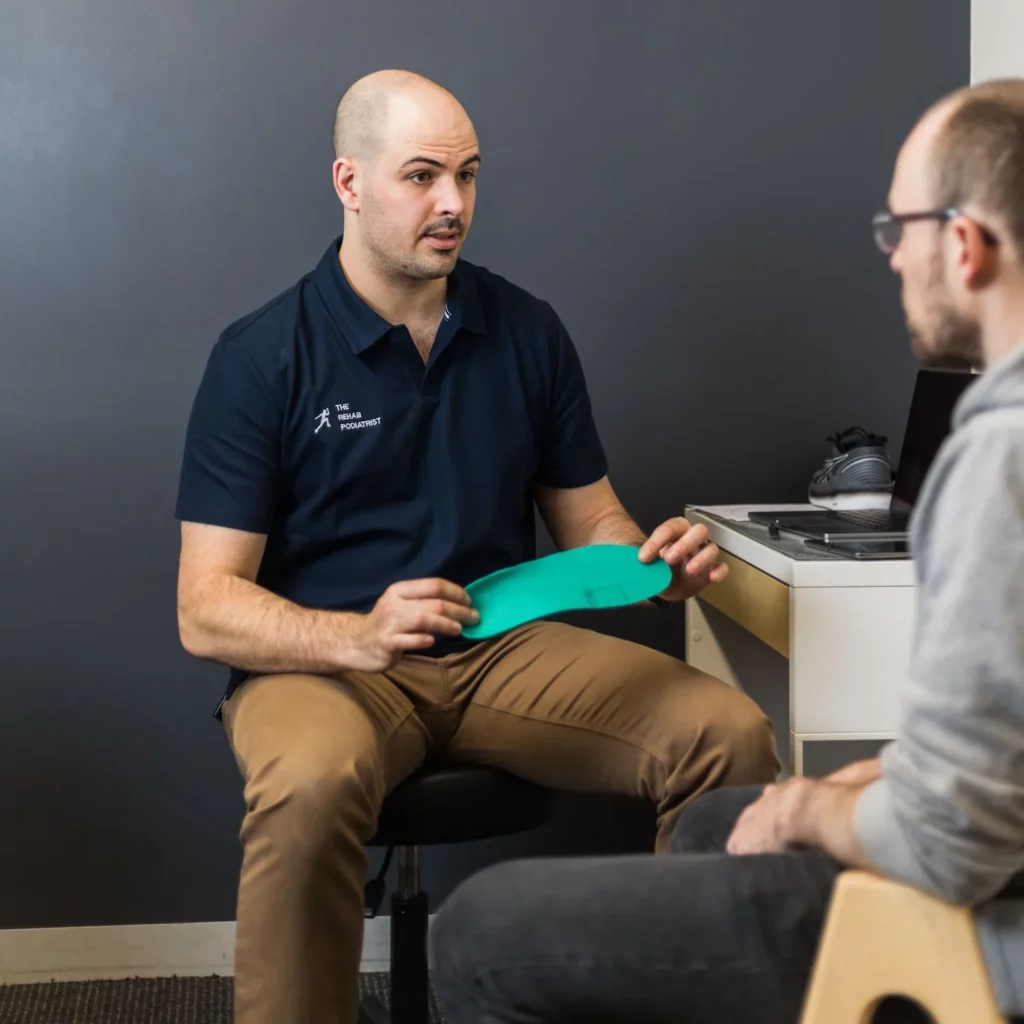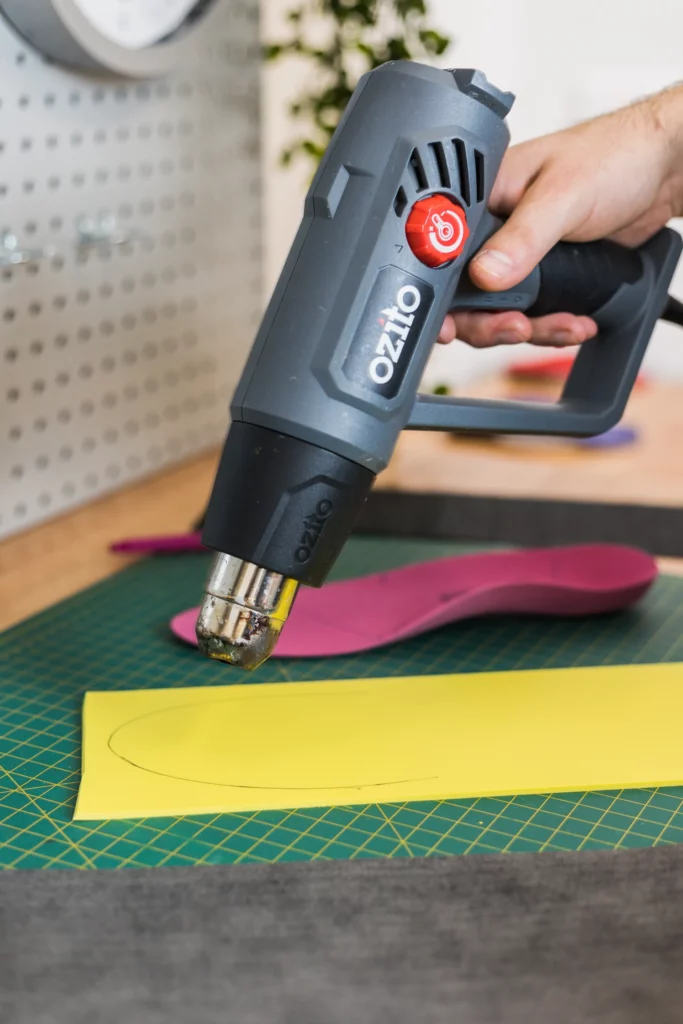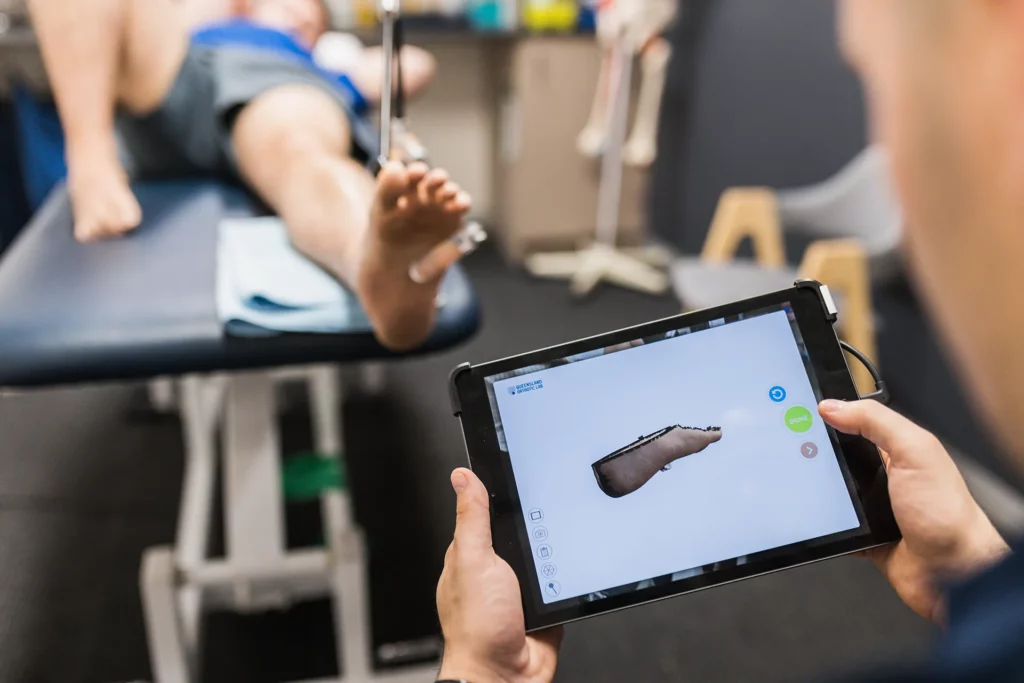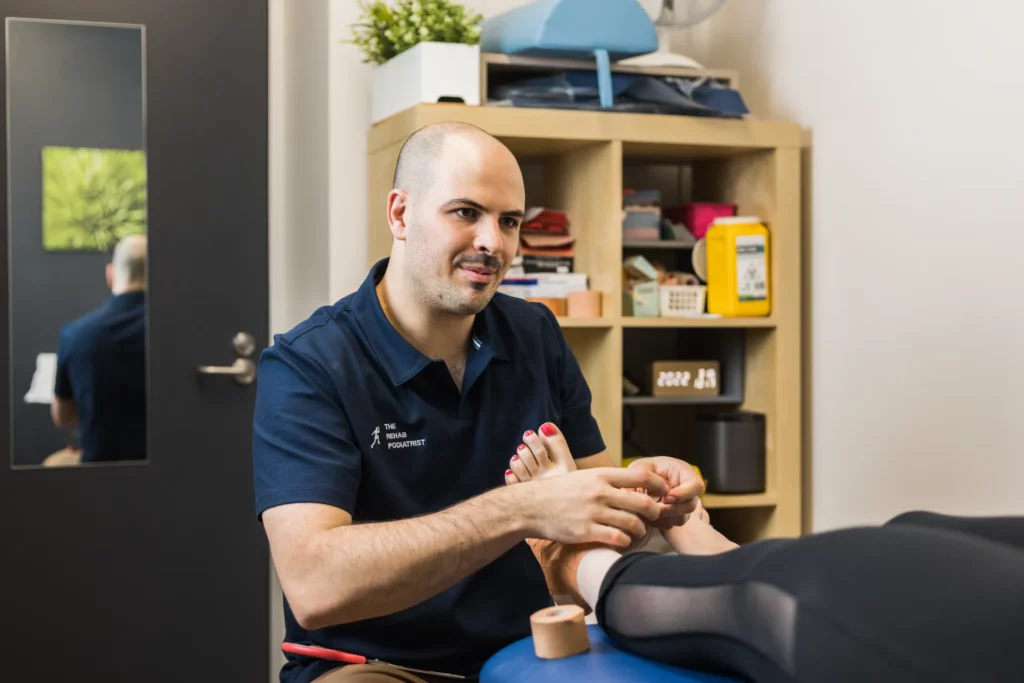Foot Orthoses and Braces

Foot Orthoses and Braces
Foot orthoses and braces are medical appliances placed in shoes that can help support feet, ankles and legs that can reduce pain and irritation.
For the right person, they can be incredibly helpful at keeping people on their feet, participating in exercise and sport, and promoting an overall recovery. In some situations, they can also be used to prevent injuries from returning.
I’m able to offer a range of different foot orthoses at different costs, that come with different benefits.
Prefabricated foot orthoses
These are foot orthoses that are premade, that are then modified for you and your condition. Being off the shelf, they can often be fitted in the same consult, or within a few days. They’re also cheaper, so can be great for more temporary conditions, or those who want to trial a level of orthotic support without committing to custom devices.
However, they aren’t as supportive compared to custom devices and there’s less options for how they’re designed. This can limit what shoes they fit into and for some people, aren’t appropriate for their condition.

Custom foot orthoses
These are foot orthoses that are made custom to your foot. This involves taking a cast or 3D scan of your foot and then a laboratory making a device to the specifications I provide them.
While more expensive, they’re also more supportive and can be designed specifically for you, your condition and what shoes you want to wear them in. They also last a lot longer than prefabricated devices. After taking an impression of your foot, on average it takes 2-3 weeks for them to arrive from the laboratory, reading for fitting.

Richie Brace (AFO)
The Richie Brace is an Ankle Foot Orthoses (AFO), which is a foot orthoses with supports connecting it to the leg, making it more supportive that an orthoses alone.
For those with more persistent or complex conditions such as severe ankle osteoarthritis, a progressively collapsing foot, foot drop or any condition that requires more ankle support, this can be a fantastic option.
Compared to other AFOs, this brace was designed by a Podiatrist specifically so people could walk, run and continue daily activities.
Not everyone is enthusiastic about having to wear a brace. But compared to other options, the Richie Brace is consistently more comfortable, easier to use and allows more movement for similar support compared to larger more rigid braces.

What to expect
As part of your assessment, I’ll discuss with you whether foot orthoses is an option you could consider and how they would benefit you. We’ll also discuss possible alternatives and their likelihood of success.
They aren’t an appropriate treatment option for everyone or every condition, so this will be a discussion
If you choose to go ahead with a foot orthoses, I’ll walk you through the fitting process. For custom orthoses and the Richie brace this will be taking a 3D scan of your foot, which can be done in most consults and bringing you back in a couple of weeks when they arrive to be fitted to your shoes.
For prefabricated devices, these can often be fitted on the spot, so there’s very little wait time. I may hold onto the devices for 24-48 hours to make customisation to improve their effectiveness.

Frequently Asked Questions
How are orthotics made?
Custom orthotics are made by taking a mould, either a physical plaster cast, or a 3D scan of your foot and sending this to a laboratory along with a prescription form for what we need. The laboratory uses the mould and my specifications to make a device that is 100% customised for you and sends them to me approximately 2-3 weeks later, where I double check them and fit them in your shoes.
Semi-custom orthotics are pre-made orthotics that can be modified to your feet and what your condition requires . I fit these by heating them up and moulding them to the shape of your foot. While not as accurate or as customisable as a custom device, they’re a good middle ground, especially if you only need an orthotic short term.
Prefabricated orthotics are pre-made orthotics that aren’t as modifiable. They also can’t be moulded to your foot, so the goal is to find a brand/type that fits your foot best, rather than being able to mould it to match. I personally don’t issue these that often, as for not much more cost, you can get a much better result from semi-custom orthotics. However, they remain an option if you’re looking for something that doesn’t need any fitting, or for a very specific shoe that needs a special design, not able to be made in semi-custom orthotics. E.g. for heels.
Will foot orthotics help my foot pain?
Foot orthoses can help a lot of conditions in the foot, ankle and knee. But they aren’t a good option for everyone.
All my appointments are based around figuring out what is going to be the best treatment plan for you and your foot pain. This may or may not include foot orthoses.
I have a flat foot. Do I need orthotics?
If you’re primary concern is your feet being flatter than average, then often the answer is no.
Foot orthotics used to be seen as a corrective device, fixing feet that were flatter. This idea came about because we saw a lot of people come into the clinic in pain with flat feet, who got better with orthotics. The assumption was the flat feet was the cause of the pain and by ‘fixing’ the feet with orthotics, it would treat the condition would stop it coming back.
We’ve now done studies that show that flat feet, by themselves, don’t mean that you’ll develop pain or injury, any more likely than someone with high arched or average arched people. We also know that in people with no history of foot injury, that orthotics don’t often prevent future risk of injury for most conditions. (There’s some caveats here, for example they can help prevent stress fractures in the foot in military recruits during basic training).
So, the main reason we would intervene for people with flat feet is when they’re suffering from pain or an injury that we identify would benefit from orthotics. It’s often temporary, meaning once the condition has resolved, they can reduce how much they’re wearing orthotics, or stop altogether.
There are some people who may benefit from wearing them longer term. E.g. people who’ve suffered from pain in the tendons along the arch of your foot, stress fractures, recurrent heel pain. However, that might not be wearing them in all shoes, maybe just shoes they’re on their feet for longer in, e.g. sport shoes.
There’s also a group of people who I see feel a lot more comfortable when standing, walking and playing sport in foot orthotics. This would be another time we would continue wearing them, despite pain or injury resolving.
There’s some rarer exceptions we see where we may issue foot orthotics for flat feet, when there isn’t any pain or injuries. For example, people that have exceptionally flat feet, people that have generalised hypermobility (i.e. very flexible across all the joints of their body), if there’s a big asymmetry (e.g. you left foot being a lot flatter than the right) or you get a lot of generalised pain and fatigue in your feet and legs.
The thing I tell prospective patients when they’re asking about whether orthotics will help is, if you’ve got something that is concerning you, the best thing to do is come in for an appointment. I’ll be able to do an assessment, explain everything that is going on and make personalised recommendations for you, including whether I think foot orthotics are worthwhile. That way you can know your options and make an informed decision.
What's the difference between hard and soft orthotics?
Hard and soft orthotics generally refer to the types of materials used to make the part of the orthotic that contours to your foot. Choosing a hard or softer shell depends on what we want the orthotic to do. There’s also a difference in life span and ability to change and modify them.
A hard shell orthotic is generally made out of different types of plastic. We can choose the thickness of the plastic and with 3D printing, this can now be done down to the 0.1 of a millimeter. The purpose of using a harder, plastic shell is that it can hold its shape more effectively (also meaning it has a longer), is easier to fit in a wider range of shoes and can be more easily repaired.
Generally we use this type of design for people with injuries and foot pain because it holds its shape well and it’s ease in swapping between shoes.
A soft shell orthotic is generally made out of a high density foam of different thicknesses and density. Meaning, we can pick the firmness from very soft to very firm. Unlike the firmer plastic devices, they are often bulkier and don’t hold their shape by themselves, meaning they require the shape of the shoe to hold them together and work effectively. This means there can be more difficulty fitting in shoes or swapping them between different shoes.
Generally, we choose to use softer shell orthotics for people who we’re trying to prevent foot wounds and corns/callouses, as the softer material is better suited to this purpose. We can also use them instead of harder shells for people who find it difficult or uncomfortable to wear the plastic shell.
Making the choice!
Part of my process for design and fitting foot orthoses is working with you to figure out what is going to work best for you, fit in your shoes and be the most comfortable. We discuss any concerns and make sure you’re getting something you’ll be happy and confident with!
How long do foot orthotics last?
This is highly dependent on the amount you wear them and what type of activity you do in them. For example, the occasion walk compared to basketball training 4 times a week. However, there’s some rough guides.
For harder shell orthotics, for average use, it’s not unreasonable to expect 5-7 years out of the device. There’s softer top covers that are often glued onto the shell that will require a repair/replacement during this time, but is substantially cheaper than the orthotics themselves.
For softer shell orthotics, for average use, it’s a lot shorter, approximately 1-3 years. Sometimes people get longer, but beyond the 3 year mark, it’s likely that the material is really compressed and the shape altered. This doesn’t mean they won’t work, but they aren’t doing anywhere near the same job as when they were first fitted.
Sometimes orthotics don’t last this long. There’s a manufacturers warranty for the first 6 months if there’s fault, but this is extremely rare. Most of the time it’s shorter it’s either extreme wear, or that the condition it’s used to treat has progressed and a new design is required. The good news is, both of these circumstances are also rare and for those who have a higher likelihood of this happening, they will be made aware before having orthotics ordered.
How much do foot orthotics cost?
Cost of foot orthotics are dependent on not only the type of orthotics you’re getting, but also the clinic and Podiatrist you see.
My fees for common services are available on my website. If there’s a service not listed you can contact me to find out more.
My orthotic prices are:
Custom 3D printed foot orthotics:
$80 3D Scan
$595 Foot Orthotics
$120 Fitting Appointment
$795 Total
Semi-Custom Orthotics
$180 Foot Orthotics
$40 Modifications (if required)
$120 Fitting Appointment
$300-340 Total
Pre-Fabricated Orthotic
Price quoted based on type needed.
Approximately guide only:
$80-200 Foot Orthotics
$120 Fitting Appointment
$200-320 Total
Can I wear my orthotics straight away? Do they take much getting used to?
While there are people who definitely can stick an orthotic into their shoes and walk all day with no problems, this isn’t common.
My advice is to my patients is that you should wear them in slowly. This is usually 1 hour on day one, 2 hours on day two etc. until you’re wearing them all day. If you’ve worn orthotics before and are replacing them with a newer set, you can often increase by 2 hours per day instead of one.
I also advise people it’s best to not go for long walks, runs or play sport in the orthotics until you can wear the orthotics all day comfortably with no issues. This lowers the risk of things like blisters occurring as it takes a little bit of time for your skin to get tougher and used to the extra pressure in the arch.
If you aren’t going to wear your orthotics day-to-day, only when you’re playing sport or running, we’ll work together to come up with a wearing in plan that suits you.
Do I have to wear orthotics for the rest of my life?
This answer is very dependent on you and your condition. However, for most people, they aren’t something you wear for the rest of your life.
We used to think foot orthotics corrected people’s foot posture and therefore prevented them from future injury.
What we’ve learnt now is that a flat or high arched foot posture is generally not a big risk factor for injury, wear orthotics doesn’t often prevent injury from occurring again and that most people don’t get huge benefits from wearing them longer than 1-2 years.
There are always exceptions. There are people that feel a lot more comfortable, confident with moving and get less fatigue wearing foot orthotics compared to not wearing them who will remain in them for longer. There’s also some conditions, such as osteoarthritis, or when someone injures ligaments in their feet and their foot starts to flatten in adulthood, where they will need to wear orthotics most of the time for the foreseeable future. But these are rarer conditions thankfully.
I've just gotten new orthotics. Is there a wearing in period?
Accordion Content
My orthotics are uncomfortable. What do I do?
Uncomfortable orthotics aren’t uncommon and thankfully are often very easy to fix.
Orthotics are designed to be modifiable, so I can best fit them to the person. While I work to get it perfect when I order orthotics (and I do this >90% of the time!), when they arrive and you try them on, there may be points of pressure or irritation that need to be changed.
This is why I have a specific fitting appointment where we try the orthotics on and make sure they work perfectly. So if there are points that need changing, I can use the on-site laboratory to make completely comfortable right then and there.
Orthotics will put pressure on your feet in new and different places. So sometimes you need to try the orthotics at home for a couple of days to see whether you get used to the pressure, or whether we need to change them. If that’s the case, I do all the modifications required included in the cost of the foot orthotics.
If your orthotics are issued by another Podiatrist and are uncomfortable, it’s best to return to them and see if they’re able to fix the issue. But if you’re still struggling, I’m able to provide a second opinion and do any modifications required.
My orthotics don't fit in my shoes. What do I do?
The first thing is to contact the Podiatrist who fitted the orthotics and discuss whether they can be modified to fit into your shoe.
The front, soft, cushioning part of the orthotic can be easily cut down and the main reason why orthotics are difficult to fit into new shoes. You can cut this down at home with a good pair of sewing scissors, however I often get my patients to pop into the clinic for a couple of minutes as it’s such an easy thing to do and means we get it right.
Some orthotics are bigger and bulkier and physically can’t fit into a shoe, even when the front cushioning is cut down to size appropriately. If they’re a high density foam or plastic, they can often be ground down by a Podiatrist to fit into slimmer shoes. However, this is a major change to their design and would change how they function. In these cases I talk to people about the pros and cons of making this change and whether a new orthotic, will a slimmer design to fit slimmer dress shoes, would be a better solution, so you can still have a more supportive orthotic for the shoes it already fits in.
My orthotics are broken, can they be repaired?
There’s lot of things on an orthotic that can be repaired.
The most common issue I see is the soft cushioning on top of the orthotic wear away or come off the orthotics. Sometimes both! These can be easily removed and new cushioning put on top of the device.
There’s also extra pieces placed on the bottom of orthotics called posting, which can also be easily replaced.
There are some things that can’t be repaired though. For example, a crack in a plastic shell, or a tear in a softer orthotic.
If you’ve got a problem with an orthotic, send me an email, or give me a call and I can let know how I can help.
